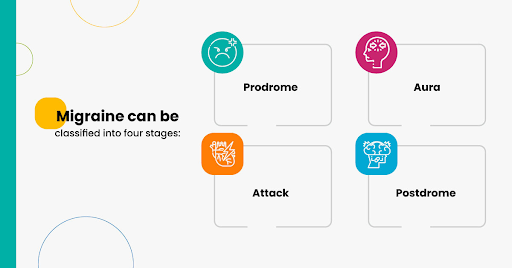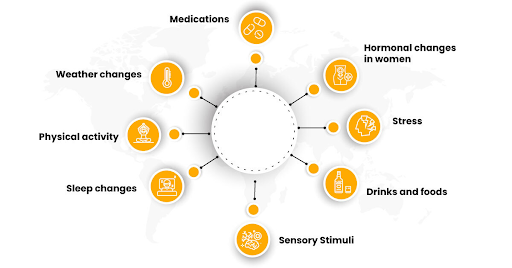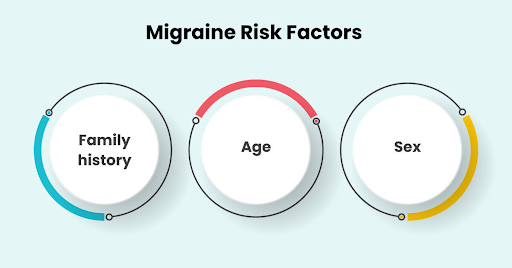
Migraine: Symptoms, triggers, risk factor and prevention
What is a migraine?
Migraine is a disease in which a person faces severe throbbing pain or a pulsing sensation. It usually happens on one side of the head. It has been observed that migraine comes with some other side effects such as nausea, vomiting, and extreme sensitivity to light and sound.
There is no specific timing when the attack of migraine will take place. It can last for one hour to many days and it can be so severe that it does not allow you to carry out daily activities.
Symptoms of migraine
Symptoms of migraine vary with the people. Every individual does not experience the same symptoms.
Migraine can be classified into four stages:

- Prodrome
People suffering from migraines suffer from certain symptoms hours or days before a headache. The symptoms are:- Tiredness
- Changes in mood
- Loss of appetite or food cravings
- Being sensitive to light, smell or sound
- Constipation or diarrhoea
- Severe thirst
- Aura
The symptoms majorly involve the vision and it stems from the nervous system. It lasts for less than an hour. The symptoms are:- Hallucinations ( Seeing things that are not there such as flashes of light, black dots, etc.)
- Sometimes experiencing loss of vision
- Arms and legs feel heavy
- Numbness in the body
- Hearing ringing in the ears
- Feeling the loss of speech or not able to speak clearly
- Attack
Migraine pain starts as a dull ache and turns into throbbing pain. The pain gets worse during physical activity. It is not necessary that if the pain starts on one side it will affect only that region, it can move from one side to another side of the head even in the front of the head. Sometimes it can hurt the entire head. For some people, it is accompanied by nausea, for some with vomiting. It can also cause one to feel faint and pale. There is no specific duration that a migraine attack can last. It can last for hours and the severe ones can last for more than a day. There is no specific time for the occurrence of migraine, it depends on person to person. It can occur two to four times in a month or once or twice in a year. - Postdrome
This can stay a day even after the headache. Some of its symptoms are:- Muscle pain or weakness
- Feeling unusually refreshed or happy
- Feeling unnecessary tiredness, weak
Migraine Triggers
Some common reasons for migraine triggers are:
- Hormonal changes in women
Many women suffer from headaches during or before their menstruation cycle, menopause, or when they are pregnant. - Stress
Stress results in the release of chemicals in the brain that can cause changes in blood vessels, one of the reasons that lead to a migraine. - Drinks and foods
Some foods and drinks are one of the prominent reasons to trigger migraines such as alcohol, coffee, food additives (nitrates). Not every individual needs to have after consumption of these items. It varies from person to person. Skipping meals or not having meals is also one of the reasons for having such throbbing pain. - Sensory Stimuli
Bright lights, sound, or smell can also result in a migraine. - Sleep changes
Lack of sleep or sleeping too much can set off a migraine. - Physical activity
Intense physical exertion that includes exercise as well as sex. - Weather changes
Change in weather, too much humidity, or sudden change in weather can make people suffer from severe pain. - Medications
Some people are allergic to some medicine i.e. certain medicines can cause migraine pain in some people and those should be avoided.

These are only some of the triggers there can be numerous depending on the person to person.
Migraine risk factors

- Family history
If any of your family members is suffering from it or earlier there was any case then you are very likely to have a migraine. - Age
Migraines can begin at any age, but in most cases, it occurs during adolescence. The severe pains occur during the 30’s and gradually the intensity of the pain decreases or the frequency of occurrence decreases. - Sex
Women are three times more likely to have migraines. https://www.mayoclinic.org/diseases-conditions/migraine-headache/symptoms-causes/syc-20360201 - Other medical conditions
Some diseases can give rise to migraines such as depression, anxiety, etc.
Conclusion:
There are a lot of myths about migraine and there are situations when people are not able to differentiate between the migraine pain and a headache. But it is necessary to understand the difference so that you don’t have to suffer from the throbbing pain again and again. You can know the difference between the two easily just refer to our app and enhance your knowledge in the medical field.
Download Now: App Store, Google Playstore
- Tags: Migraine